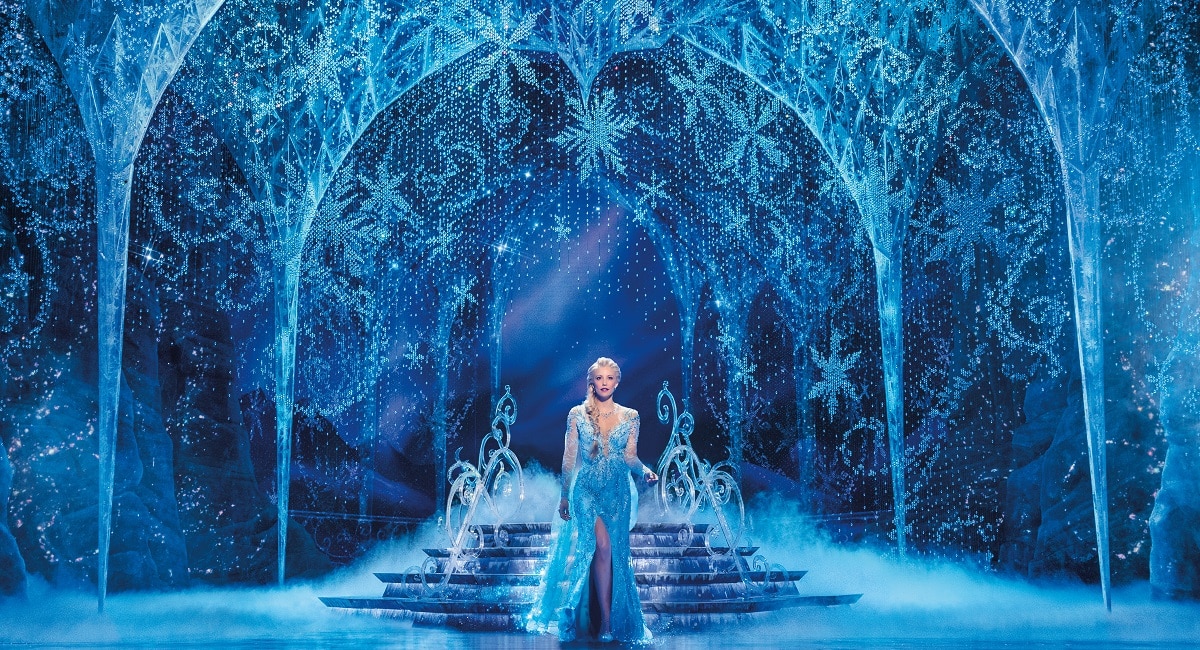DCPA NEWS CENTER
Enjoy the best stories and perspectives from the theatre world today.
Enjoy the best stories and perspectives from the theatre world today.

Caroline Bowman as Elsa in Frozen North American Tour. Photo by Deen van Meer
Disney’s Frozen, the animated film inspired by Hans Christian Andersen’s The Snow Queen, opened in the United States on November 19, 2013. An overnight, global phenomenon, the tale of two sisters driven apart by magic and reunited by love quickly became the highest-grossing animated film of all time, a distinction it held until Frozen 2 broke its record in 2019.
But before the first ticket buyer ever entered a movie theater to meet Anna and Elsa, plans were underway to create a version of Frozen for the Broadway stage. Of all Disney’s Broadway musicals, Frozen is the first to have been slated for live theatrical development before the release of the original film.
With songs by the husband-and-wife team of Kirsten Anderson- Lopez and Robert Lopez, Frozen seemed a natural for Broadway. Excited by the nearly completed film, creative executives at Disney Feature Animation reached out to Thomas Schumacher, then-president and producer of Disney Theatrical Productions, and asked him to screen a rough cut of the film.
“I set up a screening here in New York,” Schumacher remembers. “I immediately saw what Frozen was and what it was going to be for the studio, so I texted my friends there and asked, ‘When do we start?’”
“One of the first decisions we made,” Robert Lopez remembers, “is that ‘Let It Go’ would have to fall at the end of the first act.” The book writer and songwriters agreed that they would have to go deeper into the psychology of the principals and their relationships. For the stage version, trolls would transform into something earthier and more mysterious. Called “Hidden People,” these new characters were inspired by ancient Norwegian folklore.
To bring the reimagined Frozen to Broadway, Schumacher brought on British director Michael Grandage, a Tony®, Drama Desk, Olivier, Evening Standard, and Critics’ Circle award winner who has worked on new plays, modern classics, and Shakespeare, as well as musicals and operas. But he had never before directed an original musical.
Time was short by Broadway standards: 18 months from script to Broadway opening with an out-of-town tryout in Denver along the way. To design the show, Grandage brought on his partner and frequent collaborator, Christopher Oram, whose many accolades include two Tonys, one each for sets and costumes. Dances would be created by Rob Ashford, who had previously/already worked with Grandage as both a director and choreographer. “Nothing takes the anxiety out of a daunting task like working with people you know and trust,” says Grandage.
After 24 previews and 22 sold out performances in Denver during the summer of 2017, the company reassembled on January 2, 2018, buoyed by the optimism of a New Year. Harnessing that energy would prove key to transforming what Frozen was to a more complete, more finished, more nuanced show.
The opening was rethought and rewritten. The maypole scene was added to the beginning of the musical to offer a glimpse of Arendelle in happy times. The “Fixer Upper” number was restaged, adding one of the child actors to the mix. The entire “Hygge” number was restaged, as was the ending of the show on the icy fjord. A reprise of “Let It Go” replaced “Love Is an Open Door” as the finale.
Finally, on March 22, 2018, Frozen opened on Broadway and quickly established itself as the biggest hit musical of the season.
Frozen was open. But it wasn’t really “frozen.” Because Disney’s musicals have lives beyond Broadway, and that means changes to be made.
Taking a supersized stage show on tour isn’t easy. Most theaters are not big enough to accommodate sets now typical of top Broadway musicals. They do not have space under the stage for scenery to rise up from below the deck, for example. A touring production must be leaner and lighter to travel quickly and load out of one theater and into the next in just two or three days. At the same time, it is imperative for a tour to deliver the same level of entertainment, sense of scale, and impact as the original.
Happily, change can be good. Technology marches on, and there has been ample time to develop new applications that actually enhance the visual experience of the show, everything from materials used, to the way the LED lights hidden in the set pieces function.
There have been alterations to Frozen beyond the set, too. For one thing, there’s a brand-new second-act duet for Elsa and Anna titled “I Can’t Lose You.” It’s designed to bring the impossible relationship between the sisters into greater emotional focus.
“I love getting a second bite of the apple,” Schumacher says. “Movies are finished, but shows are never finished. A live stage event is different every single time you perform it. So why not improve things whenever you can? A Broadway opening isn’t the end of anything. It’s a beginning.”
DETAILS
Frozen
June 19-July 3, 2024 • Buell Theatre
Tickets
